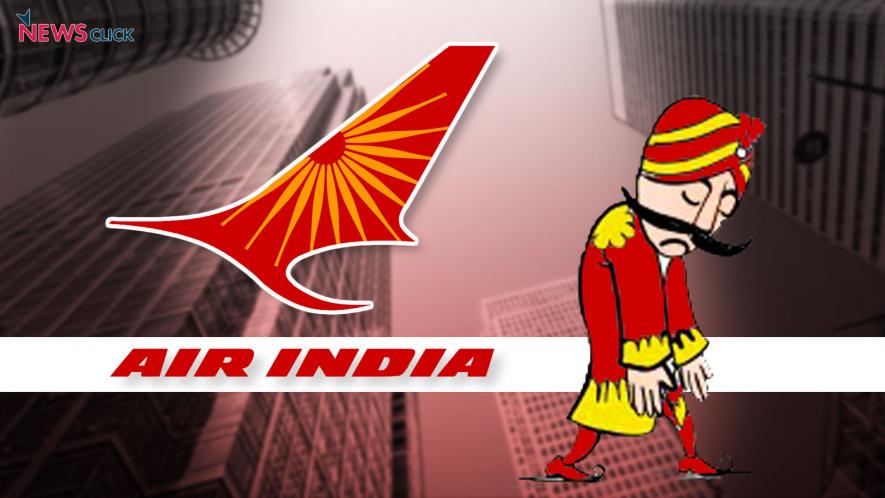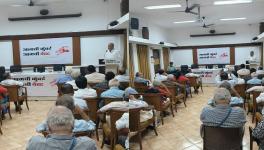Air India Sale: How To Systematically Kill A Public-Sector Company

Newsclick Image by Nitesh
The story of Air India (AI) — India’s 65-year-old “national carrier” — is a demonstration of how to first sink and then sell off a Central Public Sector Enterprise (CPSE).
But the employees of the airline — which was nationalised in 1953 — are continuing to oppose the privatisation.
On 28 March, the BJP-led NDA government announced sale of 76% equity share capital of AI held by the Government of India, along with sale of 100% equity stake in AI’s subsidiary Air India Express Limited as well as the 50% equity stake in joint venture AISATS that Air India has. The offer obviously includes the transfer of management control as well.
The ostensible reason cited is that the huge debt burden of around Rs 52,000 crore and heavy net losses (after tax) — even though Air India has been making increasing operational profits for the past three years (Rs 298 crore in 2016-17) and has never defaulted in its loan repayment.
Around Rs 22,000 crore of this debt is due to the excess aircrafts that were unnecessarily bought under civil aviation minister Praful Patel during the UPA-I regime, while a number of clearly fatal policy decisions under the same government are responsible for the accumulated losses — none of which is the fault of the company’s management. But more on that later.
Meanwhile, the BJP-led NDA is sweetening the deal for the private buyer — Indian or foreign (CPSEs or Central Government Owned Cooperative Societies are barred from bidding) — with the government vowing to bear 50% of the debt burden. The government is hiving off non-core real estate assets and other business, not integral to the core airline business, into a Special Purpose Vehicle (SPV).
These other entities are Air India Engineering Services, Air India Air Transport Services, Airline Allied Services, and Hotel Corporation of India, which will be transferred to the SPV, owned by the Government of India.
In fact, according to this report, AI is likely to be sold for a song. The report estimates the Enterprise Value (EV) of AI at Rs 45,000 crore, most of that will be offset by debt and the capitalised value of lease rentals, which ends up leaving it with an EV of a mere Rs 5,000 crore.
The eligibility criteria for the interested bidders is a minimum net worth of Rs 5,000 crore and net profit for three preceding years. However, the rules have been relaxed for Indian companies that can bid either solo or form a consortium.
In fact, it is reported IndiGo airlines — in which Praful Patel is said to have a share — will be eligible to bid solo, and indeed it has publicly expressed interest in buying AI’s airline operations in the past as well.
The government has uploaded a Preliminary Information Memorandum on its website, inviting Expression of Interest from interested bidders.
AI has been getting through with Rs 30,000-crore — Rs 3,000 crore annually — bailout package that was offered by the UPA government in 2012. And yet, AI has been registering operational profits and “consistently improving its overall financial and operational performance”, as admitted by current civil aviation minister Jayant Sinha in the Lok Sabha in February this year.
But what went wrong with Air India?
By now, it is widely acknowledged that Praful Patel is the man responsible for bringing the national airline to its knees — though, of course, the rest of the Congress-led UPA government that acquiesced to these disastrous moves cannot be excused.
A leader of the Nationalist Congress Party (NCP) and currently president of the All India Football Federation, Patel first took over as Minister of State for Civil Aviation in 2004.
“…the Government is very supportive of AI's plans to acquire aircraft. It wants AI to grow. I have directions to this effect from the Ministry of Civil Aviation and the Prime Minister,” said V Thulasidas, then chairman and managing director of AI in 2005 in an interview.
“As per the earlier plan, we were to acquire 28 aircraft 18 small capacity and 10 wide-body. This is no longer valid. Our current plan is to acquire 68 aircraft, 50 of which will be wide-body for AI and 18 smaller aircraft for Air-India Express,” Thulasidas had said.
Thulasidas talked about how AI needed to expand and become competitive, even saying that — “It has no right to continue in this business, if it cannot take on the competition.”
In fact, the government was not only “supportive” but pretty much forced AI to place orders for 68 aircrafts at a cost of Rs 50,000 crore, at a time when the company’s annual turnover was Rs 7,000 crore.
This was later pointed out and criticised by a report of the Comptroller and Auditor General (CAG) of India in 2011.
Even now, IA has an yearly interest burden of around Rs 4,000 crore — and it is worth reiterating that AI has never defaulted on the interest payment.
Then in 2006, the government began the process of merging the two state-run airlines, both of which were making profits — AI and the domestic carrier Indian Airlines (IA) — despite opposition from both.
In fact, the Indian Airlines was a market leader at the time with a 42% share. The mega merger deal in 2007 led to a loss of Rs 10,000 crore to begin with.
“The merger of Indian Airlines and Air India was the last nail in the coffin for AI,” said JB Kadian, general secretary of the Air Corporation Employees Union (a registered union more than 8,000 AI employees), while speaking to Newsclick.
“Indian Airlines was very strong. But the government did not want a domestically strong government airline. Otherwise how would private airlines make profits? The only way to promote private players was to make sure that the very name of Indian Airlines disappear from the map of Indian skies,” Kadian said.
Around the same time (2004-2005), the government was going ahead with giving away the most lucrative international routes and slots — particularly the Gulf routes — to private and foreign airlines in the name of liberalisaing “bilaterals” (commercial air travel agreements between two countries that give both the same right to operate a certain number of flights).
“Indian Airlines used to get 40% of its revenues from the Gulf routes. This was reduced to 10%,” said Kadian.
And then, the “bilaterals” were stopped, said Kadian. “Because Air India could not afford to operate flights at such high frequency, while there were conditions on private airlines to operate internationally that they did not meet at that time.”
“As a result, foreign airlines like the Emirates and even private Indian companies like Jet Airways began eating into the routes and even to dominate,” he said.
This was also pointed out in 2011 CAG report.
“So you see, with all these added aircrafts which had already heavily indebted IA, and then by the cutting of the lucrative routes by allowing private airlines to operate on those routes, IA was saddled with overcapacity. It had no utilisation for these aircrafts, even as its most profitable routes were taken away.”
Indeed, there were reasons why — in 2013 — a book titled “The Descent of Air India” was withdrawn following a defamation suit filed by Patel against its author, and former Air India executive director, Jitender Bhargava.
In May last year, based on Supreme Court directions following a petition filed by activist-lawyer Prashant Bhushan, the Central Bureau of Investigation (CBI) filed three FIRs against unknown officials of the civil aviation ministry and private persons for alleged irregularities in the UPA government’s purchase of the excess number of aircrafts, leasing of aircrafts, and surrendering of profit-making routes. It also began a preliminary enquiry into the 2007 merger of IA and AI.
In May last year as well, the NITI Aayog prepared a report recommending complete privatisation of Air India, while in June last year the NDA gave its “in-principle approval” to the strategic disinvestment of the airlines.
But the employees of AI are going to keep fighting. JB Kadian told Newsclick that the Air Corporation Employees Union as well as other unions would continue to oppose the decision to privatise AI.
“The employees have a major stake in the company. But through all these years, the employees’ unions have not been consulted even once while all these disastrous decisions were being taken,” he said.
“A private company will have no obligations towards its workers, not even social obligations like reservations. But we are not going to give up, we will intensify our struggle.”
On 29 March 2018, the Centre of Indian Trade Unions (CITU) issued a statement condemning the move and — importantly — pointing out that “the prospective buyers of Air India entities will have the obligation to retain the existing employees for only one year.”
“Never before the workers and employees who actually run the organization, are dealt with such contempt,” CITU said.
It said the BJP was putting AI on sale “by cutting the same in pieces to facilitate easy sell out”, and that the privatisation move was “anti-national”.
“The national carrier is being sold in pieces viz., Air India, AI-Sat, AI-Express, etc. and around 50 per cent of the debt burden would remain with a Special Purpose Vehicle-AI Asset Holding, keeping noncore real estate with it. This SPV along with substantial debt burden will remain with the government,” said CITU general secretary Tapan Sen in the press statement.
While AI would be taken over by private players likely in partnership with foreign aviation majors, “AI Sat, the Engineering Service and Ground handling entity, AI Express, Alliance Air, etc which are all consistently earning comfortable margin/profit will become profit-making private entities and major debt burden and liabilities will remain with Govt through SPV,” CITU said.
“The national exchequer is going to be put on heavier loss.”
Also, “unlike many major private corporate majors who are going to be the prospective buyers of dismantled Air India,” the company had never defaulted in loan repayments, it said.
Calling upon the workers and all people to oppose the “disastrous” move of privatisation of AI through a united struggle, CITU said that “the ongoing policy of privatization is nothing but a mechanism to sell out national assets and operational entities on a platter to the detriment of national interests.”
Get the latest reports & analysis with people's perspective on Protests, movements & deep analytical videos, discussions of the current affairs in your Telegram app. Subscribe to NewsClick's Telegram channel & get Real-Time updates on stories, as they get published on our website.
























